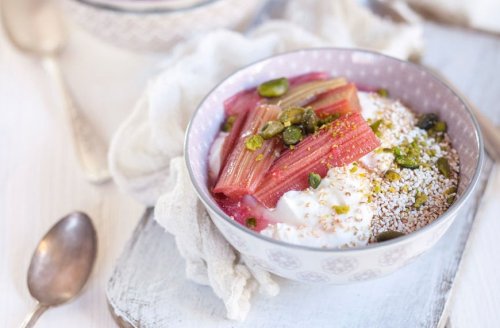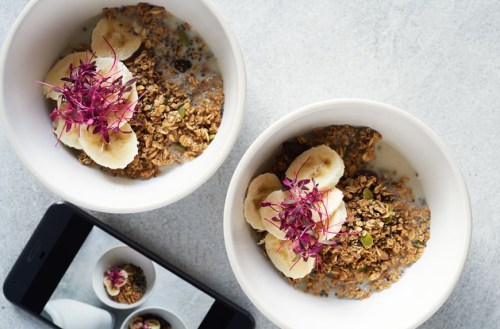Meet amaranth: The brain-boosting, gluten-free antidote to quinoa burnout
Amaranth is rich in antioxidants and minerals that can promote bone and brain health, making it a great alternative to quinoa. Plus, 7 amaranth recipes to try.

By now, quinoa is pretty much a staple in every healthy gal’s pantry. And while the gluten-free grain definitely deserves all the props it receives, throwing it into your salads and veggie burgers week after week is sure to get a little boring eventually.
The quinoa-fatigue fix? Switch up your carb rotation with amaranth, a lesser-known, yet no-less-nourishing ancient grain that’s quickly finding favor in wellness circles. Just like quinoa, it’s packed with protein and is fiber-rich, but it also has some significant health benefits all its own.
“Amaranth is an incredibly nutritious grain dating back to the Inca, Maya, and Aztec civilizations—which is why it gets described as ‘ancient’,” says BZ Nutrition owner Brigitte Zeitlin, MPH, RD. “It has an earthy, nutty flavor and is super versatile, making it easy to incorporate into your diet in numerous ways for breakfast, lunch, or dinner.”
Keep reading for more on the health benefits of amaranth and how to cook with it.

Why is amaranth so good for you?
When you compare amaranth to other grains, it’s on par with them in a lot of ways, says Zeitlin. “All whole grains are good sources of fiber and B vitamins, and amaranth is as well,” she explains. These nutrients are key for keeping your metabolism strong and your energy high, respectively.
But there are also a few areas in which amaranth exceeds the status quo. “What makes amaranth stand out from the other grains is that it’s also a great source of manganese, magnesium, and phosphorus, three key micronutrients. In a one-cup serving, you’ll get your entire day’s worth of manganese and almost half your day’s worth of magnesium and phosphorus,” Zeitlin says. “It also contains nine grams of protein per one-cup serving, which is much higher than other grains, giving you even more of a nutritional bang for your buck.”
So what does that mean for your bod, exactly? Here, Zeitlin breaks down the benefits associated with amaranth’s nutritional profile.
1. Amaranth contributes to strong cognition
“Because of its high amount of manganese, amaranth will help to boost mental cognition, as manganese plays a crucial role in maintaining healthy brain function,” says Zeitlin. “It allows you to think clearly, stay focused and alert, and helps fight off some neurological conditions.” Kind of like a whole-food nootropic, no pill-popping required.
2. It can also promote strong bones
Calcium isn’t the only mineral you need to keep your bones healthy as you age. “The phosphorus in amaranth makes it a good bone-health food, which is especially great for women with osteoporosis,” says Zeitlin. It may also prevent bones from weakening in the first place. One recent study showed that high phosphorus intake was associated with higher bone mineral content and density, as well as a reduced risk of osteoporosis, in adults over 20 years of age.
3. It may help keep your mood balanced
Amaranth’s magnesium content also plays a role in keeping your muscles and bones in peak condition, but that’s not its only superpower. “Studies have also shown that magnesium helps to reduce PMS symptoms and helps to boost mood and relieve anxiety,” says Zeitlin. You know, just in case you aren’t getting enough of it from your skin care regimen, your bath salts, your chocolate habit…
4. It’s rich in health-protective antioxidants
Zeitlin explains that amaranth is also rich in phenolic acids, a type of antioxidant. “Thanks to these antioxidants, amaranth is incredibly beneficial in helping prevent heart disease, diabetes, certain cancers, and inflammation,” she adds.

How to prepare and eat amaranth
So you’ve added amaranth to your grocery list—now what? Luckily, it’s as easy to meal-prep as any other grain, says Zeitlin. “For every one cup of amaranth, you want to use three cups of water,” she says. “Heat the water-grain combo in a pot on medium heat until it starts to boil. Once boiling, reduce the heat and let it simmer for about 20 to 30 minutes, or until all the water is absorbed.”
If you’ve got a little more time, Zeitlin recommends sprouting your amaranth—simply soak the grains in a bowl of water for 24 to 36 hours before cooking them. “Sprouted grains are easier to digest and can offer some additional nutritional benefits,” she explains.
Once your amaranth is ready to go, you can use it in just about any place you would quinoa, oatmeal, or rice, says Zeitlin—as a hot breakfast cereal, as a base for veggie bowls or stir-fries, mixed into soups and stews, or as a simple side with meat or fish. “They really are super easy to pair with anything and have more of a nutty bite to them than other grains,” she says.
To get started, try one of these delish dishes from healthy chefs and food bloggers—all of whom have added amaranth into their recipe rotations.
1. Greek Yogurt and Amaranth Berry Porridge
This decadent breakfast dish from Well+Good Council member Candice Kumai won’t just warm you up on a chilly fall morning—it’s also got beautifying benefits, as it’s topped with antioxidant-rich berries and healthy fats including almond butter and yogurt.
2. Savory Amaranth and Oatmeal Miso Porridge
If you’re not into sweet breakfasts, consider this recipe from Sprinkle of Green. Amaranth and oats are cooked with umami-rich miso paste, then topped with spicy chili flakes, crunchy pumpkin seeds and almonds, and an optional fried egg.
3. California Roll Amaranth Salad
Picture a sushi-restaurant staple deconstructed in a bowl, and you’ll have this addictive salad from Wholefully. Cucumber, avocado, amaranth, and crab meat bring the California roll flavor and texture, while a creamy tahini-ACV dressing pulls the dish together.
4. Vegan Amaranth Bowl with Garam Masala Butternut Squash
Fall flavors collide in the most perfect way in this recipe from Kitchn, wherein amaranth is topped with Indian-spiced butternut squash, collard greens, and apple slices. The recipe’s author recommends using frozen veggies to cut down on prep time.
5. Mexican Ranchero Amaranth Stew
This dish by Making Thyme for Health couldn’t be easier to make, combining amaranth, black beans, and veggies with tons of warming spices. Make a big batch and eat it throughout the week—just make sure you’ve always got extra guac on hand.
6. Amaranth Energy Balls with Dates and Cashews
Take your amaranth on the go with a batch of energy balls, featured on The Delicious Crescent. There’s no oven required to make these, and the recipe contains modifications for vegan, dairy-free, sugar-free, and low-fat eaters.
7. Crunchy Chocolate Seed Bark
Amaranth for dessert? It’s a thing. Nutrition Stripped founder and Well+Good Council member McKel Hill pops the grain like popcorn and uses it to add crunch to homemade chocolate, which also contains raw chia and hemp seeds.
Farro’s another carb on the rise—in fact, one Queer Eye star has deemed it the new brown rice. And did you know you can even get ancient grains at Chipotle now?
Sign Up for Our Daily Newsletter
Get all the latest in wellness, trends, food, fitness, beauty, and more delivered right to your inbox.
Got it, you've been added to our email list.










